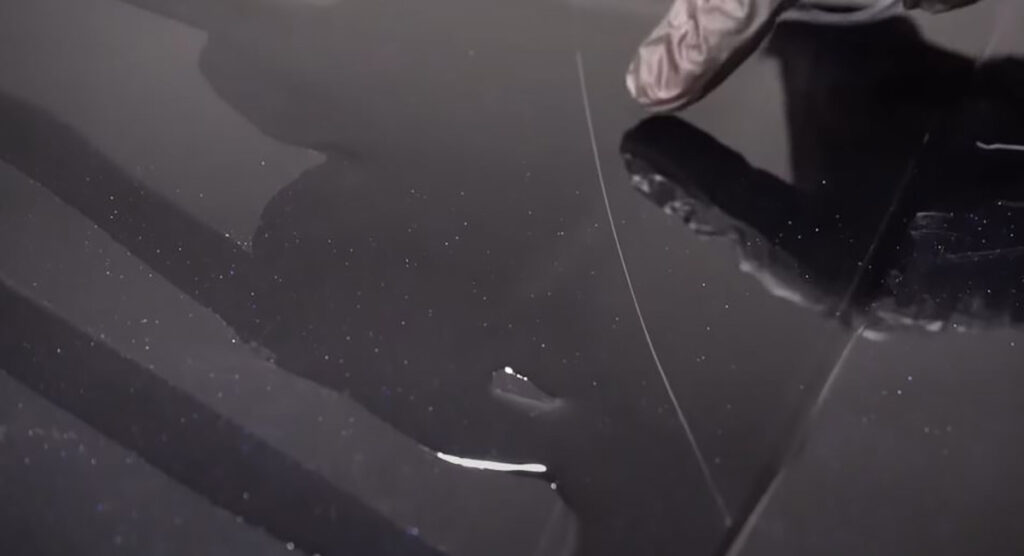When you find a scratch on your car, it doesn’t always mean it needs to be repainted. Sometimes scratches can be removed with wax, a scratch remover, or sandpaper, polish, and a car buffer. This article and video covers how to fix scratches on a car and buff them out if they’re not too deep.
Video: How to Buff and Fix Scratches on Your Car
How to Tell If You Can Fix the Scratches on Your Car

Some scratches will be cut too deep to buff or wax out. If a scratch is too deep on your car, the section will need to be sanded-downed and painted and might require the expertise of a body shop. If a scratch on your car is cut deeper than the clear coat, it will need to be sanded down, primed and painted, and then have clear coat added and get waxed/polished.
Pour Water Over the Scratches
Take a cup of water and pour it over the scratch. Scratches that don’t cut deeper than the clear coat and are probably repairable, and they will disappear when water is applied. Scratches that are too deep to be buffed out will still be visible despite the water.
When you pour water, you may notice sections of a scratch that are repairable.

How to Fix the Scratches on Your Car Easily
How to Fix Surfaces Scratches on Your Car
- Wash the Area That Has Scratches
Dust, dirt, or debris can create more scratches when waxing and buffing, so wash the car to remove any when fixing the scratch.
Rinse the car with water, wash the area with soap and water, rinse the car again, and then dry it.
- Fix Light Surface-Level Scratches with Waxers and Scratch Removers
Waxers and scratch removers might work on smaller surface-level scratches, but not the deeper kinds.
Apply the wax in circular motions over the scratches and let it dry in a cool shady area.
Some waxes and scratch removers may require you to wipe vertically, so follow the directions on the container.
Buff the wax off in up and down vertical strokes with a dry microfiber towel once the wax is dry.
- Fix Deeper Scratches with Wet Sandpaper, a Buffer, and Medium and Finer Cut Polishing Compound
If a scratch remover didn’t remove the scratches but they still faded under water, the scratch is deeper than surface-level.
Wet-sand the scratches by placing wet/dry sandpaper over a sponge to reduce pressure applied when sanding, which will prevent finger marks, more scratches, and sanding down to the paint. A sanding block may damage the paint if used in a curved area.
Start with 1200 or higher-grit wet/dry sandpaper. Dip the sponge in a bucket of water and wet the car, then dip the sponge and paper in the water. Lightly wet-sand the scratched area. This will allow you to sand down the scratches that aren’t too deep. Wipe the water from the area, and if you still see the scratch, keep sanding. Don’t sand too much so you don’t go past the clear coat. If you sand past the clear coat, you’ll have to prime and repaint the car. Sand in the direction that the wind moves against the car when it’s driving.
After wet-sanding, use a buffer that consistently spins the pad, or, if you’re less experienced and don’t want to risk removing the clear coat, use a dual action polisher. A dual action polisher won’t fully spin, so it might be the better choice for you depending on your expertise.
First, start with a medium cut polisher compound. Dab a couple of dots around the pad on the buffer, then tap the area to be polished with the buffer to get some of the compound on the paint. With the buffer on, constantly move it so you don’t burn through the clear coat. Buffing in one place for too long can remove the clear coat. Buff the surface until it looks polished.
Once complete, wipe the area clean with a microfiber cloth and inspect it. Change the pad to a smoother one and use finer cut compound. Repeat this process for the finer compound. Depending on the color, like black, it may be harder to buff the paint and you may see some swirl marks once finished. This is not an issue unless you’re looking to restore the car.
Once finished, wax the area. Follow the steps in step 2, and use a microfiber towel to wipe the dried wax away.
Learn More DIY Repairs
Find out how to fix your car with more tips from our experts. We have thousands of how-to videos for hundreds of makes and models.
Read More Automotive Tips
- Difference Between AWD and 4WD
- What Is Automotive Weatherstripping and What Are the Different Types?
- Are Brake Pads Universal?
- How to Fix Paint Chips on a Car, Truck, or SUV
Shop Parts and Tools
- Brakes & Wheel Bearing
- Headlights & Lighting
- Exterior, Body Parts & Mirrors
- Tools & Accessories
- Washes & Waxes
- Detailing Accessories
- Cleaning Cloths


